oil level AUDI S7 2013 User Guide
[x] Cancel search | Manufacturer: AUDI, Model Year: 2013, Model line: S7, Model: AUDI S7 2013Pages: 310, PDF Size: 77.45 MB
Page 237 of 310
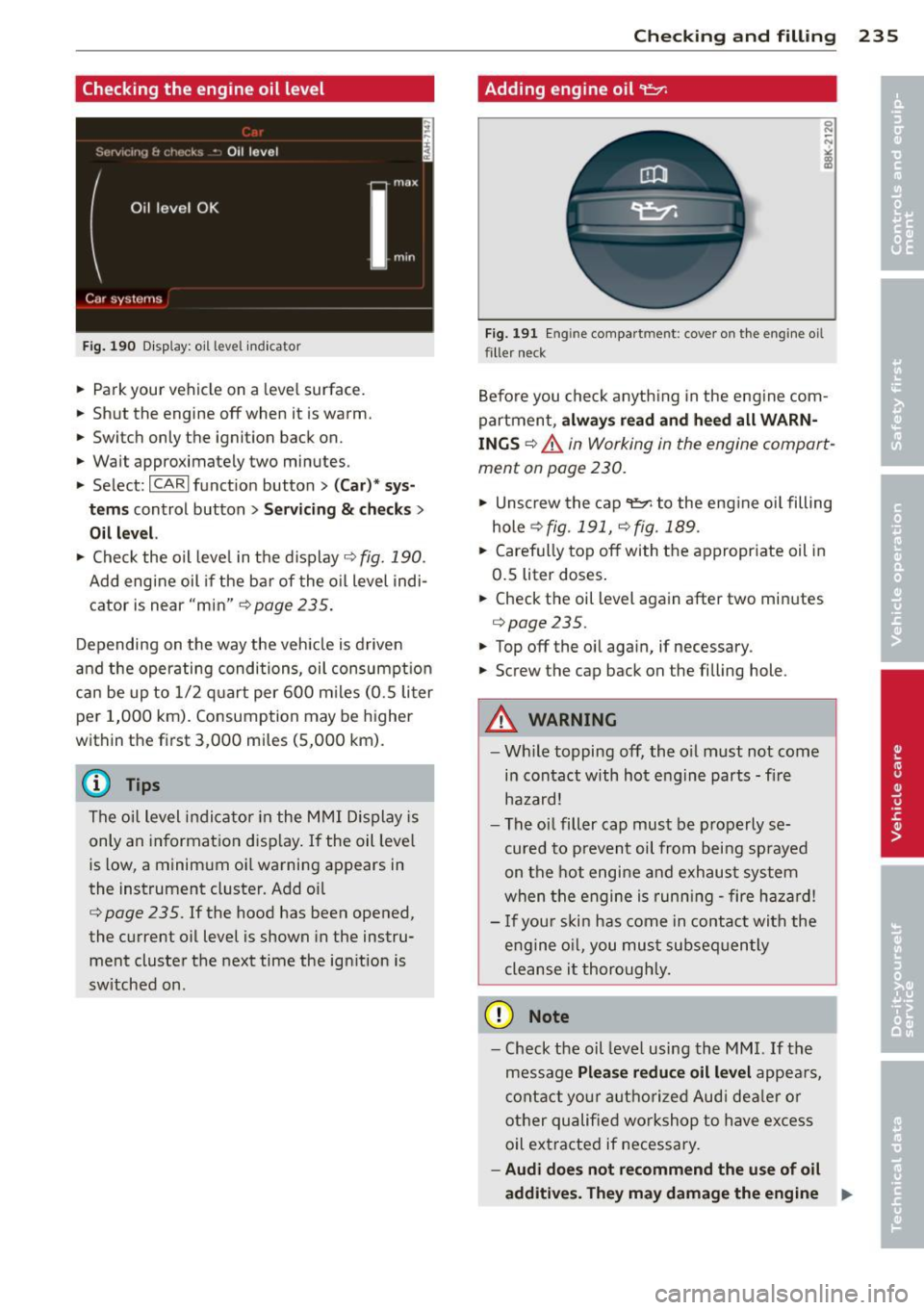
Checking the engine oil level
Fig . 190 D is p la y : o il level indi ca tor
• Park your vehicle on a lev el surfac e.
• Shut the engine off when it is warm.
• Switch only the ignition b ack on.
• W ait approxima tely two minutes .
• Se lect :
ICARI function button > ( C ar)* sys
t e m s
control button > Se rvicing & c h ecks >
Oil l ev el.
• Check the o il leve l in the display ¢ fig. 190.
Add engine oil if the bar of the oil level indi
cator is near "min "
¢page 235.
Depending on the way the veh icle is driven
and the operating conditions, oil consumpt ion
can be up to 1/2 q uart per 600 m iles (0.5 li ter
pe r 1,000 km) . Consumption may be higher
within the f irst 3 ,000 miles (5,000 km).
(D Tips
The oi l level indicator in the MMI Dis play is
only an in format ion disp lay . If the oil leve l
is low, a minim um oi l warni ng appears in
the instrument cluster. Add oi l
<=> page 235. If the hood has been opened,
the curre nt oil level is shown in the instru
ment cluste r the next time the ign ition is
sw itched on .
Checkin g and fillin g 235
Adding engine oil 'i=:1:
Fig. 191 Eng in e compa rtm en t: co ve r on the engine oi l
filler n eck
Before you check anything in the eng ine com
partment ,
alw ay s re ad and he ed all WARN
INGS ¢&.
in Working in the engine compart
ment on page 230.
• Uns crew the cap ce:r. to the eng ine oi l filling
hole
¢ fig . 191, ¢fig. 189.
• Caref ully top off with the appropr iate oil in
0.5 liter doses .
• Check t he oil level aga in after two minutes
¢ page 235 .
• Top off the o il aga in, if necessary .
• Screw the cap back on the filling hole .
A WARNING
-Wh ile topping off, the o il must not come
i n contact w ith hot engine parts -fi re
hazard!
- The oi l filler cap must be p roperly se
cured to prevent oil from bei ng sprayed
on the hot engine and exhaust system
when the engine is runn ing -fire ha zard!
- I f your ski n has come in contact with the
engine o il, you mus t subse quently
cleanse it thoroughly.
(D Note
- Check the oil level using the MMI. If the
message
Please reduce oil level appe ars,
c ontact yo ur a uth ori zed Aud i dea ler o r
ot her qualified workshop to have excess
oil ext racted if necessary.
- Audi d oes not re commend the u se of oil
additiv es. They m ay damage the engine
1111-
Page 239 of 310
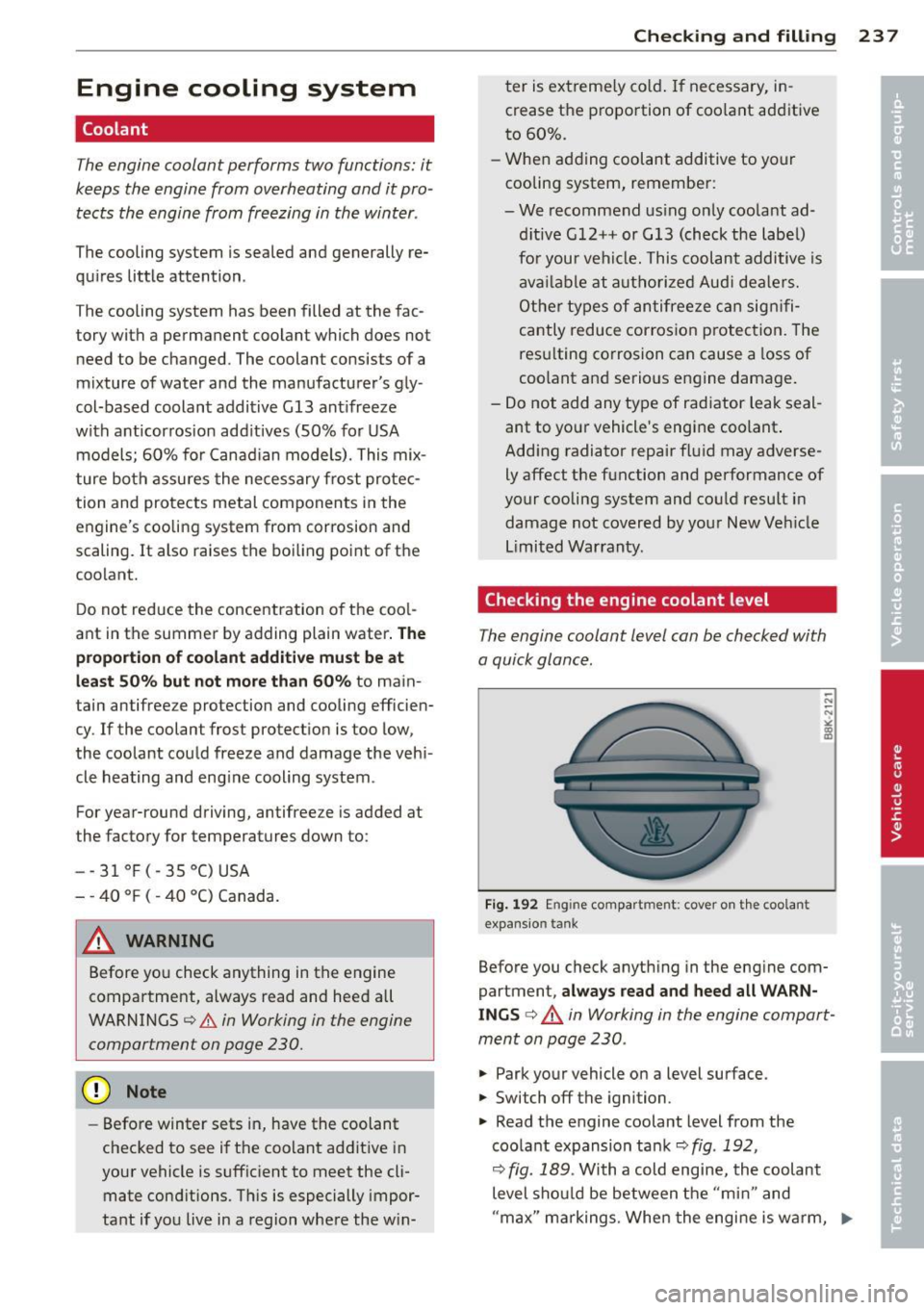
Engine cooling system
Coolant
The engine coolant performs two functions: it
keeps the engine from overheating and it pro
te cts the engine from freezing in the winter .
The cooling system is sealed and generally re
qu ires little attention .
The cooling system has been filled at the fac
tory with a permanent coolant which does not need to be changed. The coolant consists of a
mixture of water and the manufacturer's gly
col-based coolant additive G13 ant ifreeze
w ith anticorrosion add itives (50% fo r USA
models; 60% for Canad ian models). This mix
ture bot h assu res the ne cessary frost protec
tion and protects metal components in the
engine's coo ling system from corrosion and
scaling. It also raises the boili ng po int of t he
coolant.
D o not red uce the concentration o f the coo l
ant in the summer by adding plain water .
The
proportion of coolant addit ive must be at
least 50% but not mo re than 60 %
to main
tain antifree ze protection and cooling efficien
cy. If the coolant frost protection is too low,
the coolant cou ld freeze and damage the veh i
cle heating and eng ine cooling system .
For year-round driving, antifree ze is added at
the factory for temperatures down to:
- -3 1°F (-35°C)USA
- -40 ° F ( - 4 0 °C) Canada.
A WARNING
Before yo u check anything in the engine
compartment , always read and heed a ll
WARNINGS
¢ & in Working in the engine
compartment on page 230.
(D Note
- Befo re winter sets i n, have the coolant
chec ked to see i f th e coo lant ad dit ive i n
you r vehicle is suffic ient to meet the cli
mate cond itions . T hi s is especially impor
ta nt if yo u live in a regi on whe re the w in-
-
Checkin g and fillin g 237
ter is ex treme ly co ld. If necessary, i n
crease t he p ro po rtion of coo lant additive
to 60%.
- W hen a dding coolant additive to yo ur
cooling system , remembe r:
- We recommend us ing on ly coo la nt ad
di tive G 12++ or G 13 (check the labe l)
fo r you r ve hicl e. This coolant additive is
a v ailabl e at author ized Aud i de alers.
Ot he r ty pes of antifree ze can signifi
cantly reduce corros ion p rotec tion. The
r es ulting co rrosion can cause a loss of
coolant and serio us engine damage .
- Do not add any ty pe of rad iator leak seal
ant to you r vehicle's engine coo lant .
Add ing radiator repair flu id may adverse
ly affect t he fu nction and performance of
your cooling system and cou ld result in
damage not covered by yo ur New Ve hicle
L imited Warranty .
Checking the engine coolant level
The engine coolant level can be checked with
a quick glance.
Fig. 19 2 Engine co mpart ment: cover on t he coo la nt
expansio n ta nk
Before you check a nyth ing in the eng ine com
partment,
always read and heed all WARN
INGS <=>&.
in Working in the engine compart
ment on page 230 .
.,. Park yo ur vehicle on a level surface .
.,. Switch off the ignition .
.,. Read the e ngine coolant level from the
coo la nt expansion tan k<=>
fig . 192,
¢ fig. 189 . With a cold engine, the coolant
level s hou ld be be tween the "m in" and
" max" mar kings. Whe n the engi ne is w arm,
Ill>-
Page 240 of 310
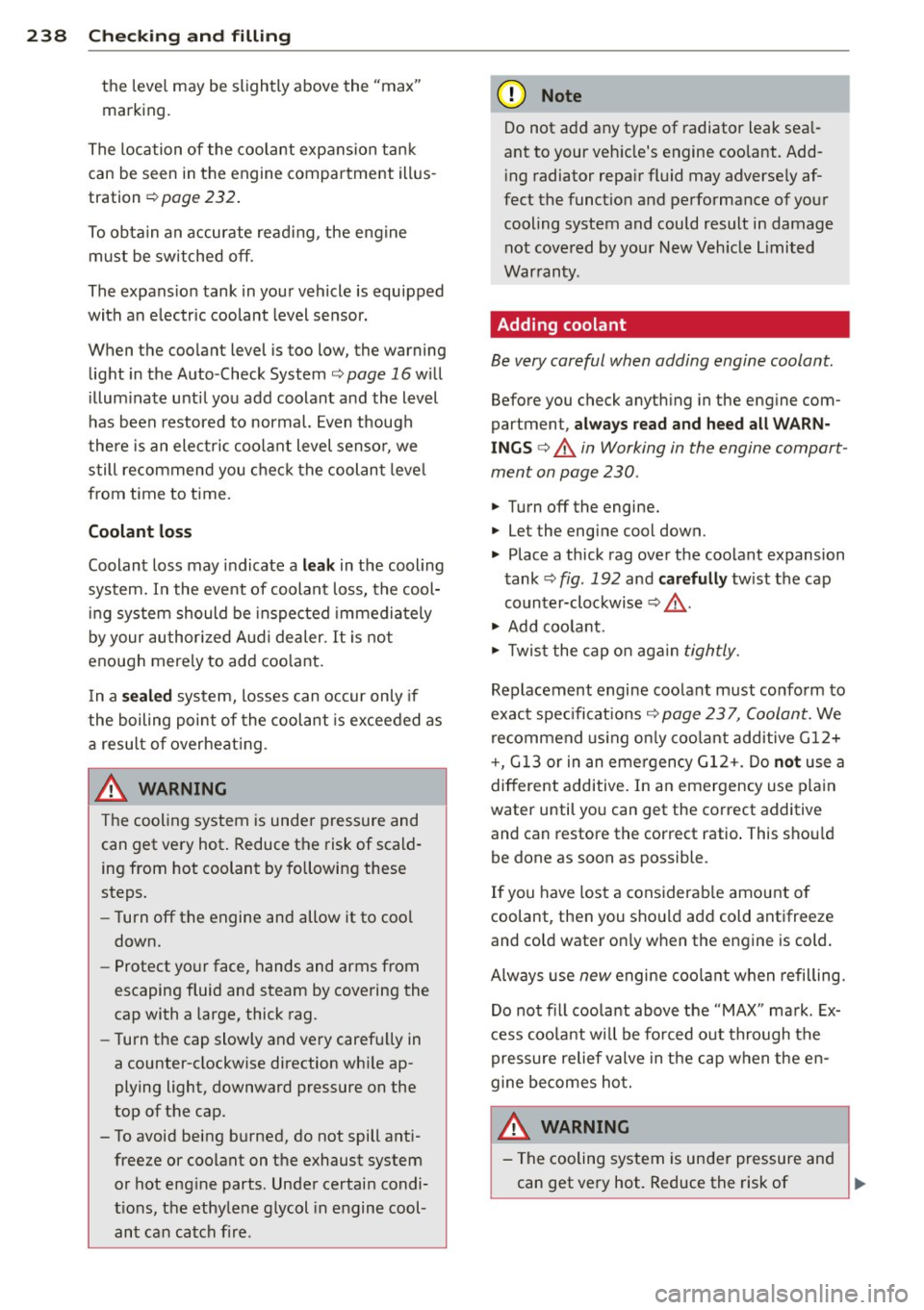
238 Checking and filling
the level may be slightly above the "max"
marking.
The location of the coolant expansion tank
can be seen in the engine compartment illus
tration
¢ page 232.
To obtain an accurate reading, the engine
must be switched off.
The expansion tank in your vehicle is equipped
with an electric coolant level sensor.
When the coolant level is too low, the warning light in the Auto-Check System¢
page 16 will
illuminate until you add coolant and the level
has been restored to normal. Even though
there is an electric coolant level sensor , we
still recommend you check the coolant level
from time to time.
Coolant loss
Coolant loss may indicate a leak in the cooling
system. In the event of coolant loss, the cool
ing system should be inspected immediately
by your authorized Audi dealer.
It is not
enough merely to add coolant.
In a
sealed system, losses can occur only if
the boiling point of the coolant is exceeded as
a result of overheating.
_& WARNING
The cooling system is under pressure and
can get very hot. Reduce the risk of scald
ing from hot coolant by following these
steps. -
- Turn off the engine and allow it to cool
down.
- Protect your face, hands and arms from
escaping fluid and steam by covering the
cap with a large, thick rag.
- Turn the cap slowly and very carefully in
a counter-clockwise direction while ap
plying light, downward pressure on the
top of the cap .
- To avoid being burned, do not spill anti freeze or coolant on the exhaust system
or hot engine parts. Under certain condi
tions, the ethylene glycol in engine cool
ant can catch fire .
(D Note
Do not add any type of radiator leak seal
ant to your vehicle's engine coolant. Add
ing radiator repair fluid may adversely af
fect the function and performance of your
cooling system and could result in damage not covered by your New Vehicle Limited
Warranty .
Adding coolant
Be very careful when adding engine coolant.
Before you check anything in the engine com
partment,
always read and heed all WARN
INGS ¢&. in Working in the engine compart
ment on page 230.
.. Turn off the engine .
.. Let the engine cool down.
.. Place a thick rag over the coolant expansion
tank ¢
fig. 192 and carefully twist the cap
counter-clockwise ¢,&. .
.,. Add coolant.
.. Twist the cap on again
tightly.
Replacement engine coolant must conform to
exact specifications ¢
page 23 7, Coolant. We
recommend using only coolant additive G12+
+, G13 or in an emergency G12+. Do
not use a
different additive. In an emergency use plain
water until you can get the correct additive
and can restore the correct ratio. This should
be done as soon as possible .
If you have lost a considerable amount of
coolant , then you should add cold antifreeze
and cold water only when the engine is cold.
Always use
new engine coolant when refilling.
Do not fill coolant above the "MAX" mark. Ex
cess coolant will be forced out through the
pressure relief valve in the cap when the en
gine becomes hot.
_& WARNING
-= -- The cooling system is under pressure and
can get very hot. Reduce the risk of ..,_
Page 293 of 310
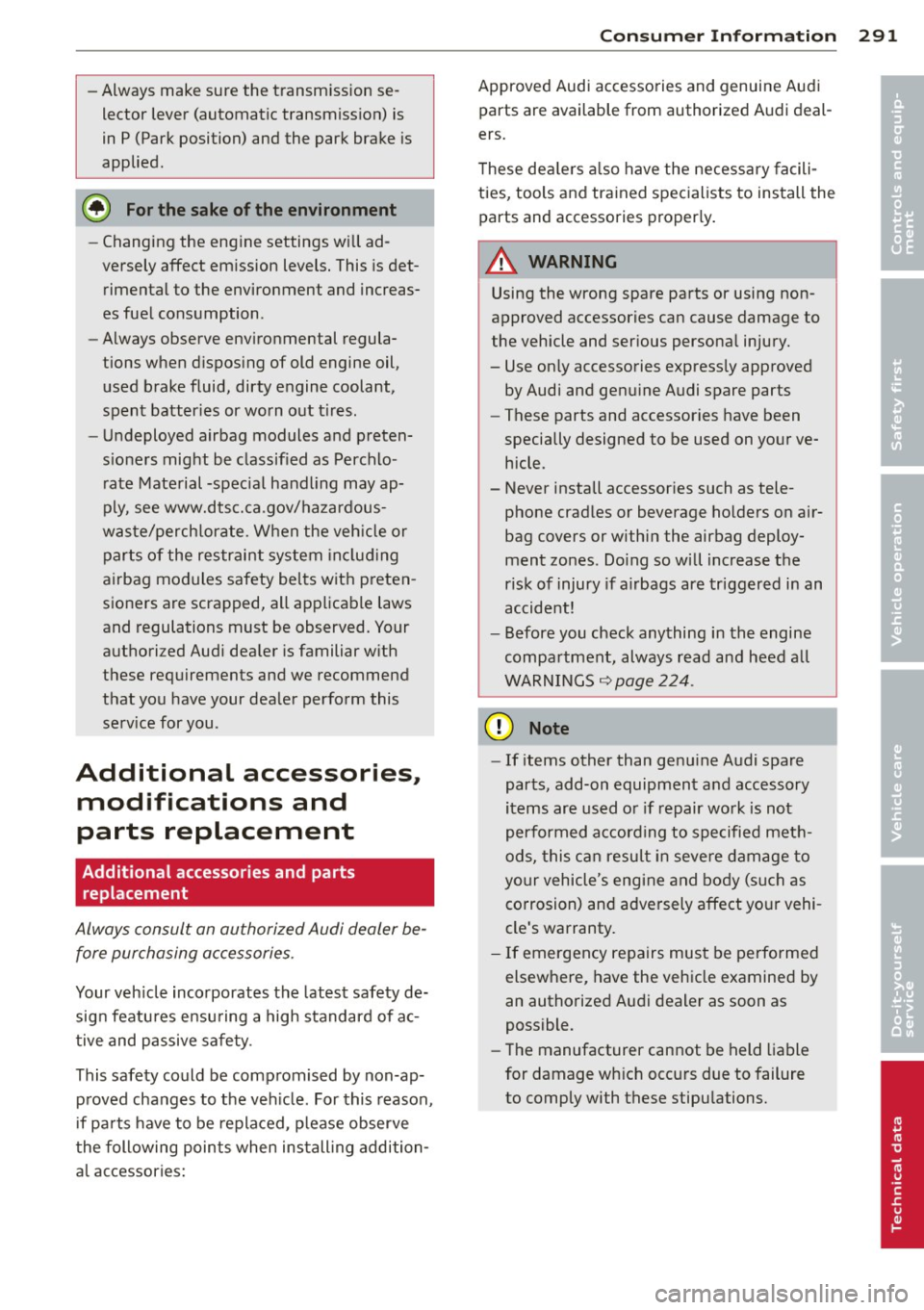
-Always make sure the transm ission se
lector lever (automatic transmiss io n) is
in P (Park position) and the park bra ke is
applied.
@) For the sake of the environment
- Changing t he eng ine settings w ill ad
versely affect em ission levels. This is det
rimental to the environment and increas
es fuel consumption .
- Always observe env ironmental regula
tions when d isposing of old engine oil,
used brake fluid, dirty engine coolant,
spent batter ies or worn out t ires.
- Undeployed airbag modules and preten
s ioners might be classified as Perchlo
r ate Mate rial -spec ia l hand ling may ap
ply, see www.dts c.ca .gov/haza rdous
was te/perch lorate. When the veh icle or
parts of the res traint system in cl ud ing
a irbag modules safety be lts wit h preten
sioners are scrapped, all applicable laws
and regulations must be observed. Your
a uthorized Audi dea ler is familiar w ith
these requirements and we recommend
that you have your dea ler perform this
se rv ice for you .
Additional accessories,
modifications and
parts replacement
Additional accessories and parts
replacement
Always consult an authorized Audi dealer be
fore purchasing acce ssories.
Your veh icle inco rporates the latest safety de
sig n featu res e nsu ring a high standard of ac
tive and passive safe ty .
This safety could be comp romised by non-ap
p roved changes to the ve hicle. For this reason ,
if pa rts have to be replaced, please observe
t he following points when ins tall ing addition
a l accessories:
Con sumer In formation 29 1
Approved Audi accesso ries and genuine Aud i
parts are available from authorized A udi deal
ers.
T hese de alers a lso have the necessary facili
ties, tools and tra ined spec ialists to install the
parts and accessories proper ly .
A WARNING
Using the wrong spare pa rts or using non
approved accessories can cause damage to
the vehicle and ser ious persona l injury.
- Use on ly accessories express ly approved
by Audi and ge nuine Audi spare parts
- These parts and accessories have been
specially designed to be used on yo ur ve
hicle.
- Never install accessor ies such as tele
phone crad les or beverage ho lders o n air
bag covers or withi n the airbag deploy
ment zones . Do ing so will increase t he
ris k of injury if a irbags are triggered in an
accide nt!
- Before you check anything in the engine
compa rtment, always r ead and heed a ll
W ARNINGS ~
page 224.
(D Note
-If items other than genu ine A udi spare
par ts, add-on equipmen t and accessory
items are used o r if repair wo rk is not
performed a ccord ing to spe cified met h
ods, this ca n resu lt in s evere damage to
yo ur vehicle's engine and body (s uch as
co rrosion) and adversely affect yo ur vehi
cle's warranty .
- If emergency repairs mus t be performed
elsewhere, have the veh icle examined by
an authorized Aud i dealer as soon as
possible.
- The manufacturer cannot be held liable
for damage wh ich occ urs due to failure
to comply with these stipu lations.
•
•
Page 297 of 310

Index 295 ____________________________ ...:.:..:.=.:::.::.:
Automatic climate control
Air vents ... ................ ... .... 72
Automatic recirculation . . . . . . . . . . . . . . 73
Operation ................... .. ....
71
Setup ... ..................... .... 73
synchronizing . ........ ... ... ... ... . 72
Automatic Shift Lock (ASL) ... ... .. .. .
110
A t t· t . .
u oma 1c ransm1ss1on ....... .. .. .. . 109
Automatic Shift Lock (ASL) . .. .. .. .. . 110
Driving .. .. ............. .. .. .. .. . 111
Emergency mode ............ ... .. . 114
Emergency release . . . . . . . . . . . . . . . . . 115
Kick-down . ................. ... ... 113
Manual shift program ..... .. .. .. .. . 113
Selector lever . . . . . . . . . . . . . . . . . . . . . 109
Automatic wipers ................ .... 47
Auto Safety Hotline ......... ... ... ..
138
Average consumption ....... .. .. .. .. .. 25
Average speed . . . . . . . . . . . . . . . . . . . . . . . 25
Avoid damaging the vehicle ...... ... .. 205
B
Bag hooks . . . . . . . . . . . . . . . . . . . . . . . . . . 65
Brake system
Anti-lock braking system .............
20
Brake assist system ................ 196
Brake booster .. .. ................. 200
Brake fluid .. .. .. .... ............. 239
Brake fluid specifications for refill and re
placement . . . . . . . . . . . . . . . . . . . . . . .
240
Brake light defective . . . . . . . . . . . . . . . . 22
Brake pads .... .. .. . ..............
204
Electromechanical parking brake ... .. . 78
Fluid reservoir ... .. ...............
239
How does moisture or road salt affect the
brakes? ....... .... ...............
199
Warning/indicator lights ........ .... . 15
Worn brake pads symbol ............ . 21
braking guard
Settings ... ... .... ................
93
Braking guard ..... .. ................ 86
Messages . .. .. .. .... ........... .. . 93
Break-in period .. .. .. ............... 204
Brake pads .. .. .. .... ... .... .... .. 204
Tires
Bulbs
....... ..... .. ...............
204
278
Battery . . . . . . . . . . . . . . . . . . . . . . . . . . .
240 C
Charging ... ................ ... ... 243
Important warnings ......... ... .. . 241
Jump starting ..................... 279
Location . .. ............. .... .. ...
241
low . .. ... . .... ............. .. .. . 202
Replacing the battery . . . . . . . . . . . . . . 244
State of charge .............. .... .. 202
Winter operation ............ .... .. 240
Working on the battery .... .. .. .. .. . 241
Before driving .. ........... .. .. .. ... 130
Blended gasoline ................... 225
Blower (automatic climate control) . . . . . . 72
Blower (climate control) . . . . . . . . . . . . . . .
69
Body cavity sealing ......... .. .. .. .. . 219
Booster seats ..... .. ...... .. .. .. .. . 184
Brake fluid
Changing the brake fluid ........... .
240
Checking the brake fluid level . .. .. .. . 239
What is the correct brake fluid level? .. 239
What should I do if the brake fluid warn-
ing light comes on? .......... .. ....
239
California Proposition 65 Warning ..... 231
Battery specific . . . . . . . . . . . . . . . . . . . 242
Capacities . . . . . . . . . . . . . . . . . . . . . . . . . 287
Engine oil ... .. .. .................
232
Car care .... .. .. .. ................. 213
Exterior ......... .. ..... .......... 213
Interior ... .. .. .. .. . .. .... ........ 219
Car carrier
Transporting your vehicle ....... .. .. 283
Cargo area ... ..... .. ...............
136
Cargo net . . . . . . . . . . . . . . . . . . . . . . . . . . . 65
Catalytic converter ... .............. . 205
Center armrest
Cockpit ... .. .. .. ................. .
54
Central locking .. .... ... ....... ...... 34
Emergency locking .. ... ....... .... .. 38
Certification .. .. .. .................
292
Changi ng a wheel .. .... ......... .... 269
Changing engine oil .. ... ....... .... .
236
Chassis (undercoating) . . . . . . . . . . . . . . . 219
•
•
Page 300 of 310
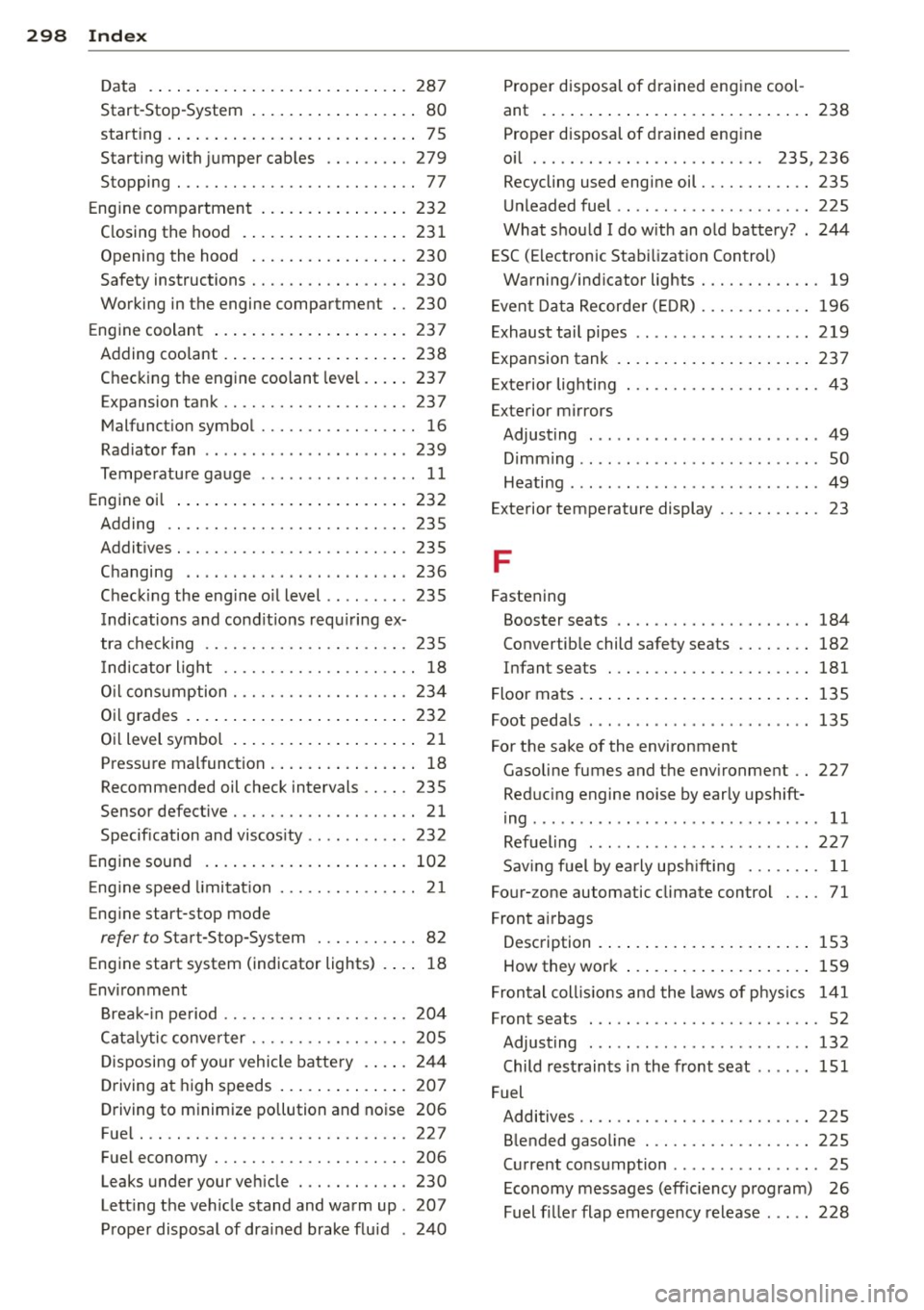
298 Index
------------------------------------
Data .... ....... ......... ... .... . 28 7
Start-Stop-System . . . . . . . . . . . . . . . . . . 80
start ing .. .. ................ ..... .. 75
Starting with jumper cables .. .. ..... 279
Stopping . . . . . . . . . . . . . . . . . . . . . . . . . . 77
Engine compartment ........ .... ... . 232
C losing the hood . . . . . . . . . . . . . . . . . . 231
Opening the hood ................. 230
Safety instructions ........ .. .. .... . 230
Working in the engine compartment .. 230
Engine coolant .................... . 237
Adding coolant ............ ... .... . 238
Checking the engine coolant level . . . . . 23 7
Expansion tank ........... .. .. .. .. . 237
Malfunction symbol ....... .. .. .... .. 16
Radiator fan .............. ... .. .. . 239
Temperature gauge ........ ..... .. .. 11
Engine oil ... ................ ..... . 232
Adding .. .... ........... .... .... . 235
Additives . .. ............. .. .. .. ... 235
Changing .... ... .... .... .. .. .. .. . 236
Check ing the engine oil level .. .. .. .. . 235
I ndications and cond it ions requ iring ex-
tra checking .. ........... .. .. .... . 235
I ndicator light ........... .. .. .. .. .. 18
O il consumption .......... .... .... . 234
Oil grades . ................. ..... . 232
Oil level symbol .................... 21
Pressure malfunction ....... ... .. .. .. 18
Recommended oil check intervals ..... 235
Sensor defective . . . . . . . . . . . . . . . . . . . . 21
Specification and viscosity .. .. .. .. .. . 232
Engine sound .............. ... .... . 102
E ng ine speed limitation ....... .. .. .. . . 21
Engine start-stop mode
refer to Star t-Stop-System ... .. .. .. .. 82
Engine start system (indicator lights) . ... 18
Environment Break-in period ......... .. .. .. .. .. . 204
Cata lytic converter ........ .. .. .. .. . 205
Disposing of your vehicle battery . ... . 244
Driving at high speeds .............. 207
Driving to minimize pollution and noise 206
Fuel . .. .. ............... .. .. .... . 227
Fuel economy ............ .... .... . 206
Leaks under your vehicle ... .. .. .. .. . 230
Lett ing the vehicle stand and warm up . 207
Proper disposal of drained brake fluid . 240 Proper disposal of d
rained engine cool-
ant ..... ..... .. .. .............. . 238
Proper disposal of drained eng ine
oil . . . . . . . . . . . . . . . . . . . . . . . . . 235, 236
Recycling used engine oil ........ .... 23S
Unleaded fuel .. .. ................ . 22S
What should I do with an old battery? . 244
ESC (Electronic Stabilization Control) Warning/indicator lights ........ .. .. . 19
Event Data Recorder (EDR) ........ .. .. 196
Exhaust tail pipes .. .......... ...... . 219
Expansion tank .... ................ . 237
Exterior lighting . ... ............ .. .. . 43
Exterior mirrors Adjusting ..... .. .. ........ ...... .. 49
Dimming . . . . . . . . . . . . . . . . . . . . . . . . . . 50
Heating ...... ... .. .............. .. 49
Exterior temperature display ...... .. .. . 23
F
Fastening
Booster seats .. .. ............. .... 184
Convertible child safety seats . . . . . . . . 182
Infant seats ... .. ............. .... 181
Floor mats . ..... .. ................ . 13S
Foot pedals ..... .. ..... ........... . 13S
For the sake of the environment Gasoline fumes and the environment .. 227
Reducing engine noise by early upshift-
ing ...... .... ... .. ................ 11
Refueling ... .. .. ....... ...... .. .. 227
Sav ing fuel by early upsh ifting . .. .. .. . 11
Four- zone automatic climate control . .. . 71
Front airbags
Description .... .. ................ . 1S3
How they work ... ................ . 159
Frontal coll is ions and the laws of phys ics 141
Front seats . . . . . . . . . . . . . . . . . . . . . . . . . 52
Adjusting ... .. .. ....... ...... .. .. 132
Child restraints in the front seat ...... 151
Fuel Additives .. .... .. ............. .... 225
Blended gasoline .............. .... 225
Current consumption .............. .. 25
Economy messages (efficiency program) 26
Fuel filler flap emergency release ... .. 228